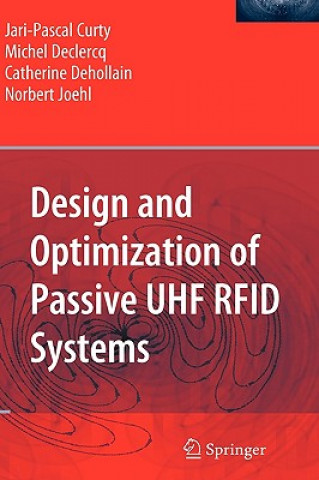
Livrare
Consilier de cumpărături





Nu se pretează? Nu contează! La noi puteți returna bunurile în 30 de zile
 Voucher cadou
orice valoare
Voucher cadou
orice valoare
Cu un voucher cadou nu veți da greș. În schimbul voucherului, destinatarul își poate alege orice din oferta noastră.
Design and Optimization of Passive UHF RFID Systems
 engleză
engleză
 318 b
318 b
30 de zile pentru retur bunuri
Ar putea de asemenea, să te intereseze


Radio Frequency IDentification (RFID) is an automatic identification method, relying on storing and remotely retrieving data using devices called RFID tags or transponders. An RFID tag is a small object that can be attached to or incorporated into a product, animal or person. RFID tag contains antenna to enable it to receive and respond to Radio-Frequency (RF) queries from an RFID reader or interrogator. Passive tags require no internal power source, whereas active tags require a power source.As of today (2005), the ubiquitous computing and ambient intelligence ideas are making their way. In order for these to become a reality, a number of key technologies are required. Briey, these technologies need to be sensitive, responsive, interconnected, contextualised, transparent and intelligent. RFID is such a technology and more particularly passive RFID tags. But, in order to deliver the necessary characteristics that could trigger ambient intelligence, there are some challenges that need to be addressed.Remote powering of the tags is probably the most important. Issues concerning the antenna-tag interface, as well as the rectifier design, that allows the RF signal to be converted to Direct Current (DC) are in pole position. Secondly, the communication link and the reader should be optimized. The RF signal that contains the tag data suffers from a power of four decay with the distance between tag and reader. As a result, both the reader sensitivity and the tag backscattered power efficiency have to be maximized. Long-range powering, as well as sufficient communication quality, are the guidelines of this work.This research project proposes a linear two-port model for an N-stage modified-Greinacher full wave rectifier. It predicts the overall conversion efficiency at low power levels where the diodes are operating near their threshold voltage. The output electrical behavior of the rectifier is calculated as a function of the received power and the antenna parameters. Moreover, the two-port parameters values are computed for particular input voltages and output currents for the complete N-stage rectifier circuit using only the measuredI-V and C-V characteristics of a single diode.Also presented in this work is an experimental procedure to measure how the impedance modulation at the tag side affects the signal at the reader. The method allows the tag designer to efficiently predict the effect of modulator design at system level and gives an useful instrument to choose the most appropriate impedances.Finally, the design of a fully integrated remotely powered and addressable RFID tag working at 2.45 GHz is described. The achieved operating range at 4 W Effective Isotropically Radiated Power (EIRP) reader transmit power is 12 m. The Integrated Circuit (IC) is implemented in a 0.5 m silicon-on-sapphire technology. A state of the art rectifier design achieving 37% of global efficiency is embedded to supply energy to the transponder. Inductive matching and a folded-dipole antenna are key elements to achieve these performances. The necessary input power to operate the transponder is about 2.7 W.
Informații despre carte
 engleză
engleză
Categorii




 Cum să cumpăr
Cum să cumpăr



























